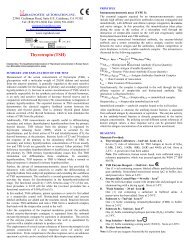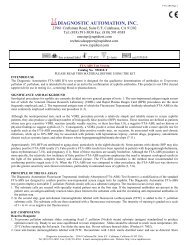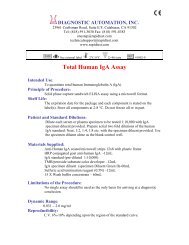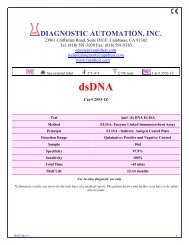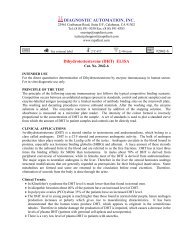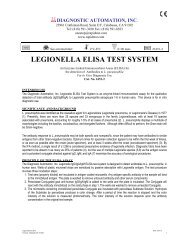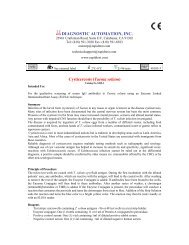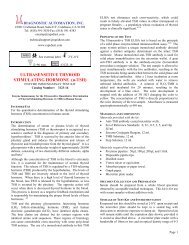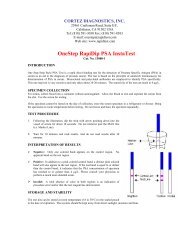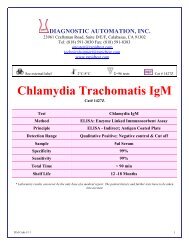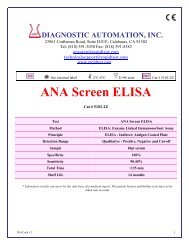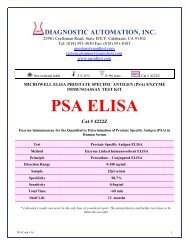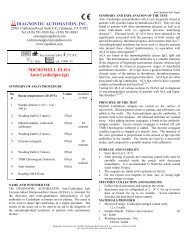Jo-1 - Diagnostic Automation : Cortez Diagnostics
Jo-1 - Diagnostic Automation : Cortez Diagnostics
Jo-1 - Diagnostic Automation : Cortez Diagnostics
Create successful ePaper yourself
Turn your PDF publications into a flip-book with our unique Google optimized e-Paper software.
DIAGNOSTIC AUTOMATION, INC.<br />
23961 Craftsman Road, Suite D/E/F, Calabasas, CA 91302<br />
Tel: (818) 591-3030 Fax: (818) 591-8383<br />
onestep@rapidtest.com<br />
technicalsupport@rapidtest.com<br />
www.rapidtest.com<br />
See external label 2°C-8°C Σ=96 tests Cat # 2570-2Z<br />
An Enzyme-Linked Immunosorbent Assay (ELISA) for <strong>Jo</strong>-1<br />
<strong>Jo</strong>-1<br />
Cat # 2570-2Z<br />
For In Vitro <strong>Diagnostic</strong> Use<br />
Test<br />
<strong>Jo</strong>-1<br />
Method<br />
ELISA: Enzyme Linked Immunosorbent Assay<br />
Principle<br />
ELISA - Indirect; Antigen Coated Plate<br />
Detection Range<br />
Qualitative - Positive, Negative and Cut-off<br />
Sample<br />
10µl serum<br />
Specificity 100%<br />
Sensitivity 96%<br />
Total Time<br />
~60 min<br />
Shelf Life<br />
12 months<br />
* Laboratory results can never be the only base of a medical report. The patient history and further tests have to be<br />
taken into account<br />
DAI Code # 2 1
INTENDED USE<br />
<strong>Diagnostic</strong> <strong>Automation</strong> ENA Profile-6 ELISA test system is a semi-quantitative immunoassay for the<br />
detection of IgG antibodies to SSA (Ro) in human sera. When performed according to these instructions,<br />
the results of this autoantibody profile may aid in the diagnosis and treatment of autoimmune connective<br />
tissue disorders. This device is for in vitro diagnostic use.<br />
SIGNIFICANCE AND BACKGROUND<br />
In recent years it has become clear that autoantibodies to a number of nuclear constituents have proven<br />
to be useful in the diagnosis of various connective tissue diseases. The <strong>Jo</strong>-1 autoantibody is one of a<br />
family of characteristic autoantibodies seen in myositis patients (19). They are all specifically found in<br />
patients with myositis, and are all associated with a high incidence of accompanying interstitial lung<br />
disease (10). Antibodies directed against the Sm marker are highly specific for patients with SLE and are<br />
considered a diagnostic criterion for SLE (1,2). The presence of high level RNP antibodies alone are<br />
considered diagnostic of mixed connective tissue disease (MCTD) and are usually associated with a<br />
more benign disease course (3), while patients with low levels of RNP antibodies, together with other<br />
autoantibodies, may be observed in the serum of patients with progressive systemic sclerosis, Sjögren’s<br />
Syndrome, and rheumatoid arthritis. The presence of RNP antibodies in the serum of SLE patients is<br />
usually associated with a lower incidence of renal involvement and a more benign disease course. To the<br />
contrary, patients with Sm antibodies experience a higher frequency of renal and central nervous system<br />
complications (4). Autoantibodies directed against SSA and SSB may be observed in patients with SLE<br />
(5-6) and Sjögren’s disease (7-9). SSA antibodies are frequently present in the serum of ANA negative<br />
SLE patients, such as subacute cutaneous lupus erythematosus (12), a lupus-like syndrome associated<br />
with a homozygous C2 deficiency (13), and in a subset of patients who lack anti-dsDNA antibodies (11).<br />
Scl-70 antibodies are highly specific for scleroderma (11). They are also observed in a minority of SLE<br />
patients. Scl-70 positive scleroderma patients tend to have a more severe disease course, more internal<br />
organ involvement and diffuse rather than limited skin involvement (14). Scl-70 antibodies are rarely<br />
found in other autoimmune diseases, and thus, their detection in a patient with the recent onset of<br />
Raynaud’s phenomenon is highly significant (15).<br />
The relative frequency of these autoantibodies in association with SLE and other connective tissue<br />
diseases either singly, or as multiple autoantibodies, requires an autoantibody profile assessment of each<br />
patient’s serum in order to obtain the highest degree of clinical relevance in the laboratory workup of<br />
these types of patients. Until recently, autoantibodies were tested individually by indirect<br />
immunofluorescence, Ouchterlony gel diffusion, hemagglutination, radioimmunoassay, or enzyme-linked<br />
immunosorbent assay (ELISA). Although the exact etiology of autoimmune diseases is unknown, and the<br />
specific role played by autoantibodies in the onset of various autoimmune connective tissue diseases is<br />
obscure, the association and frequency of detection of these antibodies, particularly those of the IgG<br />
class, by the DAI. ENA Profile-6 ELISA test system, offers an efficient test procedure for the laboratory<br />
workup of patients with various connective tissue diseases.<br />
The following table summarizes the various autoantibodies noted above with respect to disease<br />
association:<br />
Table 1 (16)<br />
Relative Frequency of Antibody Detection %<br />
Antibody<br />
Disease State<br />
Anti-<strong>Jo</strong>-1 Myositis 25-44% (19)<br />
Anti-Sm SLE 30*<br />
Anti-RNP MCTD,SLE 100** and >40, respectively<br />
Anti-SSA (Ro) SLE, Sjögren’s 15 and 30-40, respectively<br />
Anti-SSB (La) SLE, Sjögren’s 15 and 60-70, respectively<br />
Anti-Scl-70 Systemic sclerosis 20-28*<br />
* Highly Specific<br />
* *Highly specific when present alone at high titer<br />
DAI Code # 2 2
PRINCIPLE OF THE ELISA ASSAY<br />
The DAI. ENA Profile-6 ELISA test system is designed to detect IgG class antibodies to different<br />
autoantigens in human sera. Wells of plastic microwell strips are sensitized by passive absorption with<br />
immobilized antigens. The test procedure involves three incubation steps:<br />
1. Test sera (properly diluted) are incubated in antigen coated microwells. Any antigen specific antibody<br />
in the sample will bind to the immobilized antigen. The plate is washed to remove unbound antibody<br />
and other serum components.<br />
2. Peroxidase Conjugated goat anti-human IgG (γ chain specific) is added to the wells and the plate is<br />
incubated. The Conjugate will react with the antibodies immobilized on the solid phase in step 1. The<br />
wells are washed to remove unreacted Conjugate.<br />
3. The microwells containing immobilized peroxidase Conjugate are incubated with peroxidase<br />
Substrate Solution. Hydrolysis of the Substrate by peroxidase produces a color change. After a period<br />
of time the reaction is stopped and the color intensity of the solution is measured photometrically. The<br />
color intensity of the solution depends upon the antibody concentration in the original test sample.<br />
MATERIALS PROVIDED<br />
Each kit contains the following components in sufficient quantities to perform the number of tests<br />
indicated on packaging label. Note: All reactive reagents contain sodium azide as a preservative at a<br />
concentration of 0.1% (w/v).<br />
The following components are not kit lot number dependent and may be used interchangeably with the<br />
ELISA assays: TMB, Stop Solution, and Wash Buffer.<br />
Note: Kit also contains:<br />
1. Component list containing lot specific information is inside the kit box.<br />
2. Package insert providing instructions for use.<br />
PRECAUTIONS<br />
1. For In Vitro <strong>Diagnostic</strong> Use.<br />
2. Normal precautions exercised in handling laboratory reagents should be followed. In case of contact<br />
with eyes, rinse immediately with plenty of water and seek medical advice. Wear suitable protective<br />
DAI Code # 2 3
clothing, gloves, and eye/face protection. Do not breathe vapor. Dispose of waste observing all local,<br />
state, and federal laws.<br />
3. The wells of the ELISA plate do not contain viable organisms. However, the strips should be<br />
considered POTENTIALLY BIOHAZARDOUS MATERIALS and handled accordingly.<br />
4. The human serum controls are POTENTIALLY BIOHAZARDOUS MATERIALS. Source materials<br />
from which these products were derived were found negative for HIV-1 antigen, HBsAg. and for<br />
antibodies against HCV and HIV by approved test methods. However, since no test method can offer<br />
complete assurance that infectious agents are absent, these products should be handled at the<br />
Biosafety Level 2 as recommended for any potentially infectious human serum or blood specimen in<br />
the Centers for Disease Control/National Institutes of Health manual “Biosafety in Microbiological and<br />
Biomedical Laboratories”: current edition; and OSHA’s Standard for Bloodborne Pathogens (20).<br />
5. Adherence to the specified time and temperature of incubations is essential for accurate results. All<br />
reagents must be allowed to reach room temperature (20-25°C) before starting the assay.<br />
Return unused reagents to refrigerated temperature immediately after use.<br />
6. Improper washing could cause false positive or false negative results. Be sure to minimize the<br />
amount of any residual wash solution; (e.g., by blotting or aspiration) before adding Conjugate or<br />
Substrate. Do not allow the wells to dry out between incubations.<br />
7. The Sample Diluent controls, wash buffer, and conjugate contain sodium azide at a concentration of<br />
0.1% (w/v). Sodium azide has been reported to form lead or copper azides in laboratory plumbing<br />
which may cause explosions on hammering. To prevent, rinse sink thoroughly with water after<br />
disposing of solution containing sodium azide.<br />
8. The Stop Solution is TOXIC. Causes burns. Toxic by inhalation, in contact with skin and if swallowed.<br />
In case of accident or if you feel unwell, seek medical advice immediately.<br />
9. The TMB Solution is HARMFUL. Irritating to eyes, respiratory system and skin.<br />
10. The Wash Buffer concentrate is an IRRITANT. Irritating to eyes, respiratory system and skin.<br />
11. Wipe bottom of plate free of residual liquid and/or fingerprints that can alter optical density (OD)<br />
readings.<br />
12. Dilution or adulteration of these reagents may generate erroneous results.<br />
13. Reagents from other sources or manufacturers should not be used.<br />
14. TMB Solution should be colorless, very pale yellow, very pale green, or very pale blue when used.<br />
Contamination of the TMB with conjugate or other oxidants will cause the solution to change color<br />
prematurely. Do not use the TMB if it is noticeably blue in color.<br />
15. Never pipette by mouth. Avoid contact of reagents and patient specimens with skin and mucous<br />
membranes.<br />
16. Avoid microbial contamination of reagents. Incorrect results may occur.<br />
17. Cross contamination of reagents and/or samples could cause erroneous results<br />
18. Reusable glassware must be washed and thoroughly rinsed free of all detergents.<br />
19. Avoid splashing or generation of aerosols.<br />
20. Do not expose reagents to strong light during storage or incubation.<br />
21. Allowing the microwell strips and holder to equilibrate to room temperature prior to opening the<br />
protective envelope will protect the wells from condensation.<br />
22. Wash solution should be collected in a disposal basin. Treat the waste solution with 10% household \<br />
bleach (0.5% sodium hypochlorite). Avoid exposure of reagents to bleach fumes.<br />
23. Caution: Liquid waste at acid pH should be neutralized before adding to bleach solution.<br />
24. Do not use ELISA plate if the indicator strip on the desiccant pouch has turned from blue to pink.<br />
25. The calibrator must be fully reconstituted prior to performing the assay. Improper or inadequate<br />
reconstitution will produce erroneous results.<br />
26. Do not allow the conjugate to come in contact with containers or instruments that may have<br />
previously contained a solution utilizing sodium azide as a preservative. Residual amounts of sodium<br />
azide may destroy the conjugate’s enzymatic activity.<br />
27. Do not expose any of the reactive reagents to bleach-containing solutions or to any strong odors from<br />
bleach-containing solutions. Trace amounts of bleach (sodium hypochlorite) may destroy the<br />
biological activity of many of the reactive reagents within this kit.<br />
DAI Code # 2 4
MATERIALS REQUIRED BUT NOT PROVIDED<br />
• ELISA microwell reader capable of reading at a wavelength of 450nm.<br />
• Pipettes capable of accurately delivering 10 to 200µL.<br />
• Multichannel pipette capable of accurately delivering (50-200µL)<br />
• Reagent reservoirs for multichannel pipettes.<br />
• Wash bottle or microwell washing system.<br />
• Distilled or deionized water.<br />
• One liter graduated cylinder.<br />
• Serological pipettes.<br />
• Disposable pipette tips.<br />
• Paper towels.<br />
• Laboratory timer to monitor incubation steps.<br />
• Disposal basin and disinfectant. (example: 10% household bleach, 0.5% sodium hypochlorite.)<br />
STORAGE CONDITIONS<br />
1. Store the unopened kit between 2° and 8°C.<br />
2. Coated microwell strips: Store between 2° and 8°C. Extra strips should be immediately resealed with<br />
desiccant and returned to proper storage. Strips are stable for 60 days after the envelope has been<br />
opened and properly resealed and the indicator strip on the desiccant pouch remains blue.<br />
3. Conjugate: Store between 2° and 8°C. DO NOT FREEZE.<br />
4. Positive Control and Negative Control: Store between 2° and 8°C.<br />
5. Human Calibrator: Store between 2º and 8ºC. Following reconstitution, stable for 30 days between<br />
2º and 8ºC.<br />
6. TMB: Store between 2° and 8°C.<br />
7. Wash Buffer concentrate (10X): Store between 2° and 25°C. Diluted wash buffer (1X) is stable at<br />
room temperature (20° to 25° C) for up to 7 days or for 30 days between 2° and 8°C.<br />
8. Sample Diluent: Store between 2° and 8°C.<br />
9. Stop Solution: Store between 2° and 25°C.<br />
SPECIMEN COLLECTION<br />
1. It is recommended that specimen collection be carried out in accordance with NCCLS document M29:<br />
Protection of Laboratory Workers from Infectious Disease.<br />
2. No known test method can offer complete assurance that human blood samples will not transmit<br />
infection. Therefore, all blood derivatives should be considered potentially infectious.<br />
3. Only freshly drawn and properly refrigerated sera obtained by approved aseptic venipuncture<br />
procedures should be used in this assay (17, 18). No anticoagulants or preservatives should be<br />
added. Avoid using hemolyzed, lipemic, or bacterially contaminated sera.<br />
4. Store sample at room temperature for no longer than 8 hours. If testing is not performed within 8<br />
hours, sera may be stored between 2° and 8°C for no longer than 48 hours. If delay in testing is<br />
anticipated, store test sera at –20°C or lower. Avoid multiple freeze/thaw cycles that may cause loss<br />
of antibody activity and give erroneous results.<br />
PROCEDURE – STEPWISE<br />
1. Remove the individual components from storage and allow them to warm to room temperature<br />
(20-25°C).<br />
2. Determine the number of microwells needed. Allow six Control/Calibrator determinations (one Blank,<br />
one Negative Control, three Calibrators and one Positive Control) per run. A Reagent Blank should<br />
be run on each assay. Check software and reader requirements for the correct Controls/Calibrator<br />
configurations. Return unused strips to the resealable pouch with desiccant, seal, and return to<br />
storage between 2° and 8°C.<br />
DAI Code # 2 5
EXAMPLE PLATE SET-UP<br />
1 2<br />
A Blank Patient 3<br />
B Neg. Control Patient 4<br />
C Calibrator Etc.<br />
D<br />
Calibrator<br />
E<br />
Calibrator<br />
F<br />
Pos. Control<br />
G Patient 1<br />
H Patient 2<br />
3. Prepare a 1:21 dilution (e.g.: 10µL of serum + 200µL of Sample Diluent. NOTE: Shake Well Before<br />
Use) of the Negative Control, Calibrator, Positive Control, and each patient serum. The Sample<br />
Diluent will undergo a color change confirming that the specimen has been combined with the diluent.<br />
4. To individual wells, add 100µL of each diluted control, calibrator and sample. Ensure that the samples<br />
are properly mixed. Use a different pipette tip for each sample.<br />
5. Add 100µL of Sample Diluent to well A1 as a reagent blank. Check software and reader requirements<br />
for the correct reagent blank well configuration.<br />
6. Incubate the plate at room temperature (20-25°C) for 25 + 5 minutes.<br />
7. Wash the microwell strips 5X.<br />
A. Manual Wash Procedure:<br />
a. Vigorously shake out the liquid from the wells.<br />
b. Fill each microwell with Wash Buffer. Make sure no air bubbles are trapped in the wells.<br />
c. Repeat steps a. and b. for a total of 5 washes.<br />
d. Shake out the wash solution from all the wells. Invert the plate over a paper towel and tap<br />
firmly to remove any residual wash solution from the wells. Visually inspect the plate to ensure<br />
that no residual wash solution remains. Collect wash solution in a disposable basin and treat<br />
with 0.5% sodium hypochlorite (bleach) at the end of the days run.<br />
B. Automated Wash Procedure:<br />
If using an automated microwell wash system, set the dispensing volume to 300-350µL/well. Set the<br />
wash cycle for 5 washes with no delay between washes. If necessary, the microwell plate may be<br />
removed from the washer, inverted over a paper towel and tapped firmly to remove any residual wash<br />
solution from the microwells.<br />
8. Add 100µL of the Conjugate to each well, including reagent blank well, at the same rate and in the<br />
same order as the specimens were added.<br />
9. Incubate the plate at room temperature (20-25°C) for 25 + 5 minutes<br />
10. Wash the microwells by following the procedure as described in step 7.<br />
11. Add 100µL of TMB to each well, including reagent blank well, at the same rate and in the same order<br />
as the specimens were added.<br />
12. Incubate the plate at room temperature (20-25°C) for 10 to 15 minutes.<br />
13. Stop the reaction by adding 50µL of Stop Solution to each well, including reagent blank well, at the<br />
same rate and in the same order as the TMB was added. Positive samples will turn from blue to<br />
yellow. After adding the Stop Solution, tap the plate several times to ensure that the samples are<br />
thoroughly mixed.<br />
14. Set the microwell reader to read at a wavelength of 450nm and measure the optical density (OD) of<br />
each well against the reagent blank. The plate should be read within 30 minutes after the addition of<br />
the Stop Solution.<br />
DAI Code # 2 6
CALCULATIONS/REPORTING RESULTS<br />
A. Calculations:<br />
1. Correction Factor<br />
A cutoff OD value for positive samples has been determined by the manufacturer and correlated to the<br />
Calibrator. The correction factor (CF) will allow you to determine the cutoff value for positive samples and<br />
to correct for slight day-to-day variations in test results. The correction factor is determined for each lot of<br />
kit components and is printed on the Component List located in the kit box.<br />
2. Cutoff OD Value<br />
To obtain the cutoff OD value, multiply the CF by the mean OD of the Calibrator determined above.<br />
(CF x mean OD of Calibrator = cutoff OD value)<br />
3. Index Values or OD Ratios<br />
Calculate the Index Value or OD Ratio for each specimen by dividing its OD value by the cutoff OD from<br />
step 2.<br />
Example:<br />
Mean OD of Calibrator = 0.793<br />
Correction Factor (CF) = 0.25<br />
Cut off OD = 0.793 x 0.25 = 0.198<br />
Unknown Specimen OD = 0.432<br />
Specimen Index Value or OD Ratio = 0.432 / 0.198 = 2.18<br />
B. Interpretations:<br />
Index Values or OD ratios are interpreted as follows:<br />
Index Value or OD Ratio<br />
Negative Specimens < 0.90<br />
Equivocal Specimens 0.91 to 1.09<br />
Positive Specimens > 1.10<br />
Use the above guidelines when evaluating or interpreting patient specimens. Equivocal specimens<br />
should be repeated. Specimens which are repeatedly equivocal should be evaluated using an alternate<br />
serological method. Elevated autoantibody levels to any of the six autoantigens may be indicative of a<br />
specific rheumatic disorder. The SIGNIFICANCE AND BACKGROUND section of this package insert<br />
describes some of the more common diseases associated with elevated autoantibody levels.<br />
NOTE: When interpreting the anti-Sm/RNP result to determine potential anti-RNP (only) activity, one<br />
must consider the anti-Sm and the anti-Sm/RNP result simultaneously.<br />
LIMITATION OF THE ASSAY<br />
1. A diagnosis should not be made solely on the basis of the ENA Profile-6 ELISA test results.<br />
2. Test results should be interpreted in conjunction with the clinical evaluation and the results of other<br />
diagnostic procedures.<br />
EXPECTED VALUES<br />
The expected value for a normal patient is a negative result. The number of reactives, and the degree of<br />
reactivity is dependent upon parameters such as population type being tested, treatment, etc. Each<br />
laboratory should establish their own expected values based upon the specimens typically being tested.<br />
With respect to disease-state and percent reactivity, Table 1 in the SIGNIFICANCE AND BACKGROUND<br />
section of this package insert shows the relative frequency of autoantibody activity for various rheumatic<br />
disorders.<br />
DAI Code # 2 7
PERFORMANCE CHARACTERISTICS<br />
Comparative Study:<br />
A comparative study was performed to demonstrate the equivalence of the DAI. ENA Profile-6 ELISA to<br />
several other commercially available autoantibody ELISA test systems. The performance of the ENA<br />
Profile-6 ELISA was evaluated using 337* serum specimens; 152 normal donor samples from the<br />
northeastern and southeastern United States, and 185 disease-state repository samples previously<br />
characterized with respect to autoantibody activity. The results of the investigation have been<br />
summarized in Tables 1 and 2 below:<br />
* The total population tested for anti-<strong>Jo</strong>-1 was 126; 64 normal donor samples, and 62 of the disease-state<br />
repository samples.<br />
Table 1: Relative Sensitivity; Disease-State Specimens<br />
Autoantigen A B C D Sensitivity<br />
<strong>Jo</strong>-1 8 8 0 8 8/8 = 100.0%<br />
Sm 13 16 3 13 13/13 = 100.0%<br />
Sm/RNP 46 58 11 50 46/50 = 92.0%<br />
SSA 56 74 18 57 56/57 = 98.2%<br />
SSB 28 34 6 29 28/29 = 96.6%<br />
Scl-70 8 17 9 8 8/8 = 100.0%<br />
A - Number of specimens reactive on DAI. Test System.<br />
B - Number of specimens reactive on Commercial ELISA Test System.<br />
C -<br />
D -<br />
Number of discrepant specimens.<br />
Number of positive specimens in the population after resolution of the discrepant specimens using<br />
alternate methodology such as gel immunodiffusion (GID), IFA, and third-party ELISA tests.<br />
Table 2:Relative Specificity, Normal Donor Specimens<br />
Autoantigen E F G H Specificity<br />
<strong>Jo</strong>-1 64 64 0 64 64/64 = 100.0%<br />
Sm 136 137 1 137 136/137 = 99.3%<br />
Sm/RNP 141 144 3 144 141/144 = 97.9%<br />
SSA 146 146 0 146 146/146 = 100.0%<br />
SSB 147 147 0 147 147/147 = 100.0%<br />
Scl-70 151 151 0 151 151/151 = 100.0%<br />
E - Number of specimens non-reactive on DAI. Test System.<br />
F - Number of specimens non-reactive on Commercial ELISA Test System.<br />
G -<br />
H -<br />
Number of discrepant specimens.<br />
Number of non-reactive specimens in the population after resolution of the discrepant specimens<br />
using alternate methodology such as gel immunodiffusion (GID), IFA, and third-party ELISA tests.<br />
REPRODUCIBILITY<br />
To assess the intra-assay and inter-assay variability of the test procedure, a strong positive, a low<br />
positive, and a negative sample for all of the autoantigens were tested eleven times on each of three<br />
days. The mean unit value, the standard deviation, and the percent CV were calculated for each sample.<br />
The results of this study are depicted in Tables 3 - 6 below:<br />
DAI Code # 2 8
Table 3: Intra-Assay Reproducibility, ‘’High Positive’’ Specimen:<br />
DAI. ENA Profile-6 IgG ELISA<br />
Day 1 Day 2 Day 3<br />
Antigen Mean SD %CV Mean SD %CV Mean SD %CV<br />
<strong>Jo</strong>-1 459 15 3 391 22 6 385 18 5<br />
Sm 576 71 12 690 71 10 702 29 4<br />
Sm/RNP 535 73 14 426 73 17 608 76 12<br />
SSA 818 62 7 652 68 10 779 52 7<br />
SSB 1022 120 12 881 65 7 987 67 7<br />
Scl-70 669 95 14 626 65 10 726 93 3<br />
Table 4: Intra-Assay Reproducibility, ‘’Low Positive Specimen;<br />
DAI. ENA Profile-6 IgG ELISA<br />
Day 1 Day 2 Day 3<br />
Antigen Mean SD %CV Mean SD %CV Mean SD %CV<br />
<strong>Jo</strong>-1 232 11 5 189 9 4 189 8 4<br />
Sm 460 43 9 587 52 9 392 28 7<br />
Sm/RNP 184 34 18 246 34 14 216 29 13<br />
SSA 199 26 13 231 38 17 189 22 12<br />
SSB 178 29 16 167 20 12 210 25 12<br />
Scl-70 231 21 9 214 10 5 270 21 8<br />
Table 5: Intra-Assay Reproducibiliity, Negative Specimen;<br />
DAI. ENA Profile-6 IgG ELISA<br />
Day 1 Day 2 Day 3<br />
Antigen Mean SD %CV Mean SD %CV Mean SD %CV<br />
<strong>Jo</strong>-1 5 2 N/A 5 1 N/A 4 1 N/A<br />
Sm 12 3 N/A 8 3 N/A 7 1 N/A<br />
Sm/RNP 26 4 N/A 29 9 N/A 22 6 N/A<br />
SSA 27 4 N/A 14 6 N/A 13 5 N/A<br />
SSB 2 2 N/A 1 1 N/A 1 1 N/A<br />
Scl-70 5 2 N/A 5 3 N/A 3 2 NA/<br />
Table 6: Intra-Assay Reproducibility;<br />
DAI. ENA Profile-6 ENA ELISA<br />
Day 1 Day 2 Day 3<br />
Antigen Mean SD %CV Mean SD %CV Mean SD %CV<br />
<strong>Jo</strong>-1 412 38 9 203 23 11 5 2 N/A<br />
Sm 656 85 13 479 93 19 9 3 N/A<br />
Sm/RNP 532 97 18 216 42 19 26 7 N/A<br />
SSA 750 95 13 207 35 17 18 9 N/A<br />
SSB 963 108 11 185 32 17 1 1 N/A<br />
Scl-70 674 97 14 238 30 13 5 2 N/A<br />
DAI Code # 2 9
CROSS REACTIVITY<br />
Specimens negative for ANA by HEp-2 IFA and positive for IgG antibody to various antigens such as<br />
EBV-VCA, EBNA, HSV-1, HSV-2, CMV, Rubella, and/or Toxo, were tested for potential cross-reactivity<br />
using the DAI. ENA Profile-6 ELISA Test System. All specimens tested were negative on the ELISA,<br />
indicating that the potential for cross reactivity with such antibodies is not likely, and therefore, should not<br />
interfere with the results obtained.<br />
REFERENCES<br />
1. Tan E, Cohen A, Fries J, et al: Special Article: The 1982 revised criteria for classification of systemic lupus<br />
erythematosus. Arthritis Rheum. 25:1271-1277, 1982.<br />
2. Beufels M, Kouki F, Mignon F, et al: Clinical significance of anti-Sm antibodies in systemic lupus erythematosus. Am.<br />
J. Med. 74:201-215, 1983.<br />
3. Sharp GC, Irwin WS, Tan EM, Holman H: Mixed connective tissue disease. An apparently distinct rheumatic disease<br />
syndrome associated with a specific antibody to an extractable nuclear antigen (ENA). Am. J. Med. 52:148-159, 1972.<br />
4. Winfield JB, Brunner CB, Koffler DB: Serological studies in patients with systemic lupus erythematosus and central<br />
nervous system dysfunction. Arthritis Rheum. 21:289-294, 1978.<br />
5. Tan EM, Kunkel HG: Characteristics of a soluble nuclear antigen precipitating with sera of patients with systemic<br />
lupus erythematosus. J. Immunol. 96:464-471, 1966.<br />
6. Maddison PJ, Mogavero H, Provost TT, Reichlin M: The Clinical significance of autoantibodies to soluble cytoplasmic<br />
antigen in systemic lupus erythematosus and other connective tissue diseases. J. Rheumatol. 6:189-192, 1979.<br />
7. Clark G, Reichlin M, Tomasi TB: Characterization of soluble cytoplasmic antigen reactive with sera from patients with<br />
systemic lupus erythematosus. J. Immunol. 102:117, 1969.<br />
8. Alexander E, Arnett FC, Provost TT, Stevens MB: The Ro(SSA) and La (SSB) antibody system and Sjögren’s<br />
syndrome. J. Rheum. 9:239-246, 1982.<br />
9. Alspaugh MA, Talal N, and Tan E: Differentiation and characterization of autoantibodies and their antigens in<br />
Sjögren’s syndrome. Arthritis Rheum. 19:216-222, 1976.<br />
10. Marguerie C, Bunn CC, Beynon HL, et al: Polymyositis, pulmonary fibrosis, and autoantibodies to aminoacyl-tRNA<br />
synthetase enzymes. Quart. J. Med. 77:1019-1038, 1990.<br />
11. Tan EM: Antinuclear antibodies: <strong>Diagnostic</strong> markers for autoimmune diseases and probes for cell biology. Adv.<br />
Immunol. 44:93-151, 1989.<br />
12. Sontheimer RD, Thomas JR, Gilliam JN: Subacute cutaneous lupus erythematosus: A cutaneous marker for a distinct<br />
lupus erythematosus subset. Arch. Derm. 115:1409-1415, 1979.<br />
13. Provost TT, Arnett FC, Reichlin M: Homozygous C2 deficiency, lupus erythematosus and anti Ro(SSA) antibodies.<br />
Arth. Rheum. In Press.<br />
14. LeRoy EC, Black CM, Fleishmajer R, et al: Scleroderma (systemic sclerosis): Classification, subsets, and<br />
pathogenesis. J. Rheumatol. 15:202-205, 1988.<br />
15. Weiner ES, Hildebrandt S, Senecal JL, et al: Prognostic significance of anticentromere antibodies and antitopisomerase<br />
1 antibodies in Raynaud’s disease. A prospective study. Arthritis Rheum. 34:68-77, 1991.<br />
16. Mongey AB, Hess EV: Antinuclear antibodies and disease specificity. Advances in Int. Med. 36(1): 151-169, 1989.<br />
17. Procedures for the Handling and Processing of Blood Specimens: NCCLS Procedure H18. Approved guideline.<br />
18. Procedures for the collection of diagnostic blood specimens by venipuncture: NCCLS Procedure H3, Approved<br />
Standard.<br />
19. Sturgess A: Review; Recently characterized autoantibodies and their clinical significance. Aust. N.Z. J. Med. 22:279-<br />
289, 1992.<br />
20. U.S. Department of Labor (OSHA):Occupational Exposure to Bloodborne Pathogens. Final Rule. 21CFR 1910.1030.<br />
Date Adopted Reference No.<br />
2005-09-15 DA-ENA Profile-6-2010<br />
DIAGNOSTIC AUTOMATION, INC.<br />
23961 Craftsman Road, Suite D/E/F, Calabasas, CA 91302<br />
Tel: (818) 591-3030 Fax: (818) 591-8383<br />
ISO 13485-2003<br />
Revision Date: 07-08-2010<br />
DAI Code # 2 10



